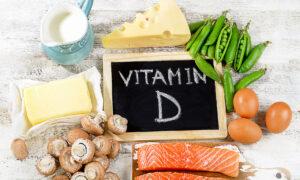One in five Americans regularly reach for vitamin D supplements, yet most are unaware that they’re taking not just a vitamin— but a hormone.
Vitamin D: Understanding Its Dual Role
Vitamin D stands apart in the world of nutrients. It’s a sun-sourced substance acting as both a nutrient and a hormone. This dual role is significant, as hormones, which orchestrate many bodily functions, aren’t typically taken as supplements like vitamins.Endocrinologist Dr. Michael Holick, a leading vitamin D expert, tells The Epoch Times, “The body more effectively utilizes vitamin D when it’s naturally synthesized from sunlight, compared to standard supplement doses.” This difference is key to understanding vitamin D’s health role and the complexities of supplementing a hormone.
Beyond Bone Health
Vitamin D is more than just a bone health and immune system booster. Its multifaceted role in the body impacts everything from mood regulation to cardiovascular health.Moreover, vitamin D is pivotal for immune health. Dr. Holick observes, “Vitamin D receptors are in almost every cell, including immune cells.” Proper levels are vital for a balanced immune response and preventing autoimmune disorders.
Mental health is another arena where vitamin D plays a significant role. Kimberly Parker, a licensed psychotherapist, told The Epoch Times, “There’s a clear link between low levels of vitamin D and higher incidences of depression and mood disorders.”
Vitamin D’s Journey From Sunlight to Cellular Powerhouse
Vitamin D is vital for health, existing in different forms, each taking a unique path within our body. Grasping these forms is key to understanding how vitamin D functions in our system.Once vitamin D enters our body through sun, diet, or supplements, it transforms to become active. First, it changes into calcidiol in the liver, then into calcitriol, its active form, in the kidneys. Dr. Holick clarifies, “Calcitriol is the form that our body can use to perform various functions.”
Interestingly, each form of vitamin D undergoes a similar conversion process in the body. The source of vitamin D might differ, but the pathway it takes in our bodies converges.
Controversies in Vitamin D Testing
The routine way to measure vitamin D levels in the body is through a blood test called 25-hydroxyvitamin D. This measurement reflects vitamin D levels from sunlight, food, and supplements. The less recommended 1,25-dihydroxyvitamin D test fails to gauge vitamin D reserves, rendering it ineffective for patient monitoring.Once led by giants like Abbott, Siemens, and Quest Diagnostics, the vitamin D testing market is now seeing a surge in home testing kits from smaller companies. Dr. Holick recalls, “Years ago, I told Quest that this would be their number one seller.”
“Vitamin D has been hyped massively,” he states. “We do not need to be checking the vitamin D levels of most healthy individuals.” He challenges the evolutionary need for high vitamin D, noting its limited presence in natural foods and reduced synthesis in darker skin, common in sun-rich areas.
Aligning with this view, Dr. Goodyear emphasizes the tests’ relevance, particularly regarding inflammation and chronic diseases like cancer. He told The Epoch Times, “Vitamin D will always be low in the place of significant inflammation, both acute and chronic,” advocating for regular monitoring for proper supplementation.
Dr. Goodyear draws an analogy to salmon swimming upstream against a current of inflammation, illustrating the challenges in increasing plasma vitamin D levels in such conditions. He likens this process to standard medical practices like monitoring blood pressure, emphasizing the need for a similar approach in natural therapies, “The process is to evaluate, dose, re-evaluate, and then re-dose,” he adds.
Defining Optimal Vitamin D Levels
According to the U.S. Preventative Services Task Force, “No consensus exists on the definition of vitamin D deficiency or the optimal level of total serum 25-hydroxyvitamin.”| nmol/L | ng/mL | Category |
|---|---|---|
| <30 | <12 | Deficiency |
| 30 to <50 | 12 to <20 | Insufficient |
| ≥50 | ≥20 | Adequate |
| >125 | >50 | Adverse effects |
Contrasting these guidelines, voices like Dr. Goodyear’s claim current vitamin D dose recommendations are too low. He labels the current U.S. recommended daily allowances as “woefully inadequate.”
Too Much of a Good Thing?
Vitamin D is vital, however, there’s concern about its overconsumption, particularly via supplements. Unlike water-soluble vitamins, which our bodies can quickly expel when in excess, vitamin D is fat-soluble and can accumulate in the liver and fat tissues to harmful levels, termed “vitamin D intoxication.”Dr. Holick cautions that vitamin D intoxication, though extremely rare, is severe. Sun exposure can’t cause Vitamin D toxicity, but excessive supplementation can. “Any excess vitamin D made by the sun is destroyed by the sun. You can never become vitamin D intoxicated from sun exposure, but you can from supplements if you take too much,” he warns.
Vitamin D toxicity triggers excessive calcium in the blood, leading to nausea, vomiting, and weakness. If untreated, it can escalate to kidney damage, bone pain, and, rarely, death.
Some practitioners, including Pam Schoenfeld, a registered dietitian, assert that excessive vitamin D intake can lead to the depletion of retinol, the active form of vitamin A. Ms. Schoenfeld told The Epoch Times, “The current landscape of vitamin D supplementation often neglects the intricate balance with other crucial fat-soluble vitamins.”
The Vitamin D Supplementation Dilemma
Modern indoor lifestyles and diets low in vitamin D contribute to widespread deficiencies. Despite well-balanced diets, about 1 in 4 American adults and 70 percent of children fall short of necessary vitamin D levels.However, not all practitioners agree that supplementation is necessary for everyone. “Although many studies had linked low levels of vitamin D to an assortment of medical conditions, when scientists tried administering it as a means to prevent or treat those problems, this ‘wonder’ supplement failed miserably,” Dr. Tavel told The Epoch Times.
Sunshine, a prime vitamin D source, can fulfill needs with minimal exposure. Dr. Tavel notes, “Your vitamin D storage generally lasts for about 10 to 12 weeks,” questioning the need for constant supplementation.
The vitamin D deficiency debate is complex. Dr. Tavel points out that “the widespread notion that much of America is walking around deficient in vitamin D came from a likely misinterpretation of the normal levels for vitamin D set by the Institute of Medicine more than a decade ago.” This has led to overestimation of deficiency rates and potentially unnecessary supplementation.
Yet, he explains, there are specific scenarios where supplementation is beneficial. The American Academy of Pediatrics advises 400 IU of vitamin D daily for breastfed infants. Those with medical conditions or limited sun exposure might also benefit.
Vitamin D’s necessity varies. Dr. Tavel reminds us, “For much of human history, people got their vitamin D mostly from the sun,” highlighting our body’s innate ability to regulate this nutrient.
Expanding Vitamin D Supplement Industry
The vitamin D supplement market is rapidly growing, valued at $1,560 million in 2023 and expected to reach $2,780 million by 2033, growing at 5.9 percent annually. Drivers include an aging population, heightened health awareness, and a surge in demand for vitamin-enriched products.In response to consumer demand, the industry is innovating with new delivery methods and formulations, like gummies, sprays, patches, creams, and potent capsules. This variety meets diverse preferences and needs, including ease of use and better absorption.
Best Sources of Vitamin D
Sun exposure is key in vitamin D production. UVB (ultraviolet B) rays convert skin cholesterol into vitamin D3, later transformed into calcitriol, its usable form. Interestingly, skin-produced vitamin D remains in the bloodstream for about twice as long as when ingested by food or vitamins.Vitamin D supplements are available as D2 (from plants) and D3 (from animals). D3, mirroring the body’s sun-induced production, is often recommended for effectively raising and maintaining vitamin D levels.
However, Dr. Holick asserts that “physiologic doses of D2 and D3 raise vitamin D levels in the blood the same,” effectively debunking myths about their differing impacts on health. Additionally, he confirms that the kidneys equally metabolize both forms.
Dr. Holick also touches on the regulatory history of these supplements in the United States, explaining that vitamin D2 remains the only pharmaceutical form available due to historical U.S. Food and Drug Administration approval processes. “No one ever got approval for D3,” he notes, highlighting a regulatory, rather than a health-based, reason for vitamin D2’s dominance in the market.
Key Considerations for Vitamin D Supplementation
Understanding how to optimize vitamin D supplementation and reduce risks is crucial:Fat-Soluble Nature
Contrary to popular belief and many recommendations, Dr. Michael Holick argues that vitamin D absorption doesn’t depend on dietary fat. He cites studies showing better absorption from skim milk, low in fat, than from full-fat milk. Hence, vitamin D can be taken with or without dietary fat.Conjunction With Other Nutrients
- Vitamin K: Studies suggest taking vitamins D and K together may enhance bone health and reduce arterial calcification risks.
- Magnesium: Magnesium aids vitamin D metabolism, and high vitamin D doses can deplete magnesium levels. Adequate magnesium is vital for effective vitamin D use.
- Vitamin A: Vitamins A and D, both fat-soluble, work together, but consensus on taking them together has not been clearly established.
- Timing of Dosage: Some suggest aligning vitamin D intake with circadian rhythms, proposing daytime consumption to avoid sleep disturbances. However, Dr. Holick indicates no evidence supporting the idea that vitamin D disrupts sleep, making it safe to take at any time.
- Choice of Vitamin D Type: While D2 (ergocalciferol) comes from plants and fortified foods and D3 (cholecalciferol) from animal products and sunlight exposure, Dr. Holick states both forms raise and maintain vitamin D levels equally.
- Consult Health Care Professionals: Before starting supplements, consulting a health care provider is essential to determine proper dosing and assess potential interactions with other medications or health conditions.







